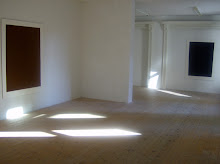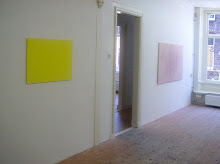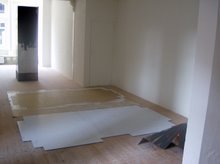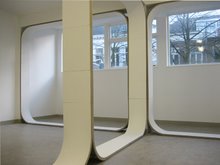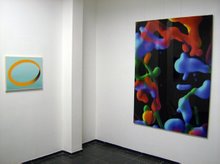Hello,
first of all I would like to thank you Joke and Jacob the invitation, for your boldness to take an exhibition from Bonn, and to invite a collegue who himself has not much more knowledge about all this technical stuff, the equipement and so on.
But finally it happened that everything went well and all tools and equipment is working.
This show was shown in Bonn, at the Gesellschaft for Kunst und Gestaltung beginning this year.
Curator is Michael Graeve, who lives in Melbourne and works on his PHD on the subject of the history of sound installation, but who unfortunately was not able to come over for this show here.
As I mentioned already I personally don’t know a lot about how it looks like inside a speaker or any other technical device.
Let’s call it black box – the speaker or a syntheziser . I had a child’s imagination, what happens when the needle runs over the record on an old record player, or even worse, what made a synthesiser sound like it sounds on Pink Floyd records (for example)…
The world of sound art was a more or less mysterious one for me and is most probably for some of you.
But this project, this show has changed my point of view a little bit, and hopefully this might happen to some others as well.
Geometry seen in recent sound
A strange title and idea - maybe . How can we combine the visible (and just visible) and the audible, unless you have synesthetic abilities.
Yet there is a simple connection between sound and some geometrical form – if you think of a wave – lets say a sinus wave. We all can imagine the image of this wave.
But a pure sinus wave is a very harsh and not really nice sounding thing. If we hear a Piano or a wind instrument we never hear the pure version of a sinus wave. We hear the mixture of lots of combinations and overtones…
And we know there or more waves then sinus waves, like rectangular and triangular waves.
Nicolas Collins who is known as one of the most radical artists - if you look for self made electronic instruments
He wrote a book, it’s an instruction manual how to build electronic instruments yourself :
‘Homemade Electronic Music: The art of hardware hacking’
This is the Bible for sound puzzler. If you have the chance to see bigger Collins installations you would expect some complicated looking installations with lots of wires and computers to create sound.
But in this show Michael picked a sort of prototype which does not sound at all, but shows the way how Nicolas works on a simple level.
Collins uses any stuff from everyday life. This can be tin boxes, a loud speaker from a child’s toy… or anything else.
And here it is a used, found chocolate box. The box shows a triangular red sign on the front. According to it Nicolas Collins built an electronic tool which would create triangular waves.
Well, of course you have to connect it to an amplifier and some speakers…
In Collins installations the result is not a visual, or let’s say: The artist is not interested in the visual result. It might be a humorous starting point. He just takes it as a tool to create his sounds. The geometry that is presented is an incidental geometry. What we see is a black box and here we can see inside the black box.
Rolf Julius, who died unexpected beginning this year, works on a familiar field. He creates waves and minimal sounds that then interfere with material he sets into the actual world, like small stones, papers on a window, pigment placed on a square shaped cardboard. The sound comes out of little loudspeakers that usually sit behind the stones, papers, or like here, glass.
How he creates the sound is not important. It’s a composition he does according to the aimed result.
When I first saw a Rolf Julius work this was in the roof floor of the Museum Weserburg in Bremen. I saw big beams holding the roof and heard little or low noised sounds, like cracking of wood, but this was just my illusion. Minutes later I found mini speakers sitting on the floor – hidden under small stones. My perception misled me…
Here we see a glass and a speaker behind. The visual tells me something, but the ear is most probably overstrained. The ambiance noises are very often much more present that the “small sounds” by Julius. Does the glass interfere with the noise or sound that exists behind the glass. What is that, what we hear. Does the sound come from a recording which has to do with the glass…?
Julius does not answer the questions.
But he brings us to a deceleration.
While Julius and Collins create the sound themselves it is absolutely different in Joyce Hinterdings work. She is like many other artists interested in recording or detecting of waves and sounds.
Here it is the world and you (or you or you or me) who produces the sound.
We hear some sound which reminds us of the disturbing sound of some interaction of an interfering transmitter with our TV or radio.
And we see two papers with geometrical patterns.
Where is the connection?
If we come nearer we find the answer. The sound changes dependant on my presence – or dependant on the electricity which surrounds us 24/7.
Hinterding builds antennas – a gold leaf one and a plumbago one (Grafit) - which detect the electrical wave and interferences between for example the neon lamps and my body.
But this happens everywhere, always, not just in art or with this installation. Our body always responds to energetic or electronic power, although we usually don’t realize this, irrespective of the point that we rather don’t want to think of it.
This work is a allegory of how we respond to things and how things respond to us. An allegory about “there is no emptiness”. The beauty and the strange or unsettling grows together.
A brilliant concept about us, being captured in interaction which happens anyhow, anytime, anywhere. We perceive presence of how we interact with the world and visa versa.
The detection of the waves, energy from the world is brought to a special pureness in Hinterdings work. Toshiya Tsunoda (who is one part of the Collaboration Duo of Grave + Tsunoda) does familiar stuff, but so different as well.
In the small corner of experimental sound art Michael Graeve is a worldwide well know and often invited artist, who’s performances are vibrating and dense. He uses old record players as instruments…
Graeve works as well working in sound as well as in visual media (Painting and installation).
Tsunoda is one of the most consistently creative field recordists working today.
He is well known for his way how to pick up an record sounds we usually never are able to hear but which are surrounding us all the time – like the vibration of a steel beam in a big loading zone for lorries.
In this piece Tsunoda recorded the sound of a running brook or a little creek via an underwater hydrophone, while Graeve recorded a room filled with old domestic record players playing without any records.
Using a score derived by a colour-field painting done by Graeve these recordings were divided up into parts, and arranged alongside sections of recorded low frequencies, mostly outside of the reach of the human ear.
The way the pieces are cut up and arranged is complicated, and reading the notes does not really help. In general we could say, it seems that the artist’s intentions were partly to try and create a work that is formed via a seemingly symmetrical structure, but to test the listener’s ability to listen for different structures and patterns in the music.
However it is arranged, the music is a curious, partly unsettling, partly hypnotically relaxing work. Tsunoda’s bubbling brook seems to appear a lot less often than Graeve’s softly roaring gramophone abrasions, but perhaps this is an illusion, as many things are.
Sometimes the bass tones cannot be heard at all, sometimes they are a distant presence, Throughout, the sounds we hear are quite lovely, never aggressive or confrontational, just arranged in such a way that they refuse traditional listening approaches. The sounds come and go as they please, flicking on and off rather than fading in and out.
This music is in many ways an ascetic, harsh work, but then on the other hand the recorded sounds all have an emotional attachment, either the restful sound of nature of the nostalgic sound of a misplaced record player needle.
While Graeve and Tsunoda have not met ever and did the whole communication and composition via internet and emailing the cooperation or collaboration between Graeve & Dahlhausen
(who is me) was just the opposite.
Michael and I have both two fields to feel at home in the art world: Music and visual art.
I studied Cello ages ago and since I met Michael Graeve the first time, we worked together in both fields. The most recent result of this collaboration is this object on the wall.
2010 we went into a professional sound studio in Melbourne, I myself with my Violon Cello – its sound got altered through two electronic pick ups and an electric amplifier, Michael came with his worn out record players, tapes, amps and boxes.
After some discussion about patterns and ingredients for the improvised composition we played something like 6 hours and recorded several tracks.
Nothing was changed after the recording. We just choose the best tracks, mastered them and burned them on a CD. One extra track was produced as a transparent polycarbonate Single disc, which you can see on the wall here.
You can hear it, though we would need a record player – I am sorry all are left in the studio in Melbourne – NO !...
This placement here is more about the illusion (or imagination) of the geometrical form which we all know from the turning on the record player, the round and the spiral, the layers of sound and memory, of colour and material – in visual art and sound art.
Hinterdings work responds directly to the (your) body, your presence. This work here on the wall does it on a different level – for example via reflection.
The black old TV in the front of this room shows patterns, digitally developed perpetuation of a green light point on its way through the plane.
Robin Fox composed a sound piece by using an oscillator and then wrote a computer program which links the visual result with sound.
We all know the boring images and patterns we see when listening to an audio CD on our computer. The images that come are the same - independent whether we listen to Mozart, Rolling Stones or Enya for example. These are random images.
Not here: In Robin Fox work the visual follows the sound exactly.
Michael Graves work has a minimalist approach. In contrast to this we could call Robin Fox a Maximalist. He loves drama and often includes lots of video beamers in his international travelling performances and shows.
There was a nice story about the comparison between Michael and Robin. Some years ago both needed a new washing machine. They discussed the options. Michael bought a simple one with 5 buttons, Robin took the one with 20 buttons, fuzzy logic and digital interface…
As I said he’s a maximalist.
If we now enter the small room and see the last work by Bruce Mowson, I must say: You better do it alone or in smaller groups. If the room is crowded the most of the work is hard to experience.
Bruce Mowson is a field recorder as well, but more a visual artist, although the recorded and digitally alienated sound is a very important part of the his work.
We see a round pink structure – a “Fleck”, unsharp, slowly and slightly changing.
It is impossible to focus correctly or successfully on the round thing.
Take time (PLEASE) to wait long enough to experience this.
The sound creates a mysterious and strange mood. Associations of machine sound might come and are intended. The sound originally comes from a very short and silent track, wind recorded in the staircase of a car park. Then Mowson digitally enlarged and sampled it to create a more stronger, but still not physical sound.
At the same time the visual aspect is more non physical, but the colour is !. A friction is developed !
This is even increased by the title: Pink balls…
Why balls. If there is one, we see just one.
The connotation is intended to by an erotic or sexual one, which fits to colour.
The work shows something round, which is moving, but : It’s not about socker.
Allthough I hope you will have some fun! Thank you!
Christoph Dahlhausen, Groningen, 23.10.2011























